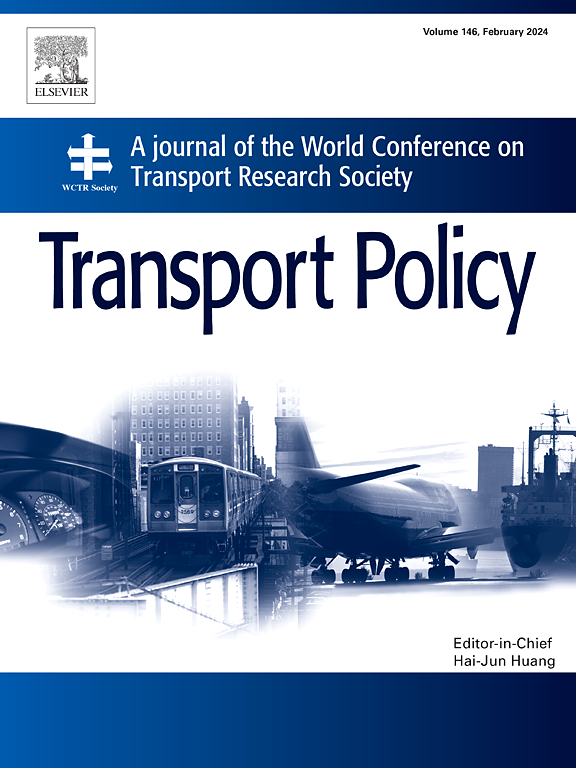基于仿真的综合公共交通服务实施前成本评估框架
IF 6.3
2区 工程技术
Q1 ECONOMICS
引用次数: 0
摘要
对综合和共享交通服务日益增长的需求催生了许多公私伙伴关系,公共交通机构和交通公司合作扩大交通服务的覆盖范围。尽管如此,由于财政限制和低乘客率,许多合作努力都失败了。许多集成系统的失败可归因于集成系统实施前评价的无效。这种失败的原因可能是缺乏可靠的业绩评价工具,无法在实施前评估综合系统的业绩。考虑到这一差距,本文提出了一个多式联运系统决策过程的支持工具,该工具检验了由固定路线交通(FRT)服务系统和按需服务组成的综合移动服务系统的可行性。决策过程由基于代理的仿真框架提供支持,该框架测试涵盖各种模态集成策略的场景。按需服务可以是需求响应运输(DRT)和运输网络公司(TNC)服务,特别是作为FRT的馈线,以确保第一英里和最后一英里的连接。本研究提出四种整合策略,包含十个潜在整合情境和四个非整合情境,共包含十四种可能情境,以完成任何出发地对之间的旅程。利用基于智能体的仿真模型,构建出发地对的各种场景,并根据广义系统成本选择首选集成策略。提出的模型通过结合三个关键成本组成部分:用户成本、代理成本和外部成本,分析了每个场景的广义系统成本。所提出的方法在两个不同的网络上实现,这两个网络是苏福尔斯网络和美国田纳西州莫里斯敦城市网络的现实案例研究。模拟结果表明,苏福尔斯网络中69%的行程和莫里斯敦73%的行程可以使用支线服务作为第一英里和最后一英里连接解决方案连接到现有的FRT网络。结果表明,合理评价综合系统可显著提高森林资源可达性。因此,所提出的方法在集成系统实施前评估其优势,协助交通规划者和政策制定者有效执行集成策略,增强用户体验和移动性。本文章由计算机程序翻译,如有差异,请以英文原文为准。
Simulation based pre-implementation cost evaluation framework for integrated public transit services
The growing demand for integrated and shared mobility services has resulted in a number of public–private partnerships, where public transit agencies and mobility companies collaborate to expand transit service coverage. Nonetheless, many collaborative efforts have failed due to financial restraints and low ridership. The failure of many of the integrated systems can be ascribed to the ineffective pre-implementation evaluation of the integrated system. The lack of a reliable performance evaluation tool capable of assessing the integrated system’s performance prior to implementation could be the case of such failures. Considering this gap, this paper proposes a support tool for decision process of multimodal integrated transport system that examines the viability of an integrated mobility service system comprised of a Fixed Route Transit (FRT) service system and on-demand services. The decision process is powered by an agent-based simulation framework that tests scenarios covering various modal integration strategies. The on-demand services could be Demand Response Transit (DRT) and Transportation Network Company (TNC) services, that particularly act as feeders for FRT to ensure first and last-mile connectivity. This study proposes four integration-strategies with ten potential integration scenarios and four non-integration scenarios, comprising a total of fourteen possible scenarios to complete a trip between any origin–destination pair. Using the agent-based simulation model, various scenarios can be constructed for origin–destination pairs, and based on the generalized system cost, the preferred integration strategy can be selected. The proposed model analyzed the generalized system cost for each scenario by incorporating three key cost components: user cost, agency cost, and external costs. The proposed method was implemented on two different networks, which are the Sioux Falls network and a real-world case study of the Morristown city network in Tennessee, United States. Simulation outcomes indicate that 69% of trips in the Sioux Falls network and 73% of trips in Morristown could be connected to the existing FRT network using feeder services as first and last-mile connectivity solutions. The results suggest that a properly evaluated integrated system could enhance the accessibility of FRT significantly. Therefore, the proposed methodology assesses the advantages of the integrated system prior to its implementation, assisting transit planners and policymakers in the efficient execution of integration strategies and enhancing user experience and mobility.
求助全文
通过发布文献求助,成功后即可免费获取论文全文。
去求助
来源期刊

Transport Policy
Multiple-
CiteScore
12.10
自引率
10.30%
发文量
282
期刊介绍:
Transport Policy is an international journal aimed at bridging the gap between theory and practice in transport. Its subject areas reflect the concerns of policymakers in government, industry, voluntary organisations and the public at large, providing independent, original and rigorous analysis to understand how policy decisions have been taken, monitor their effects, and suggest how they may be improved. The journal treats the transport sector comprehensively, and in the context of other sectors including energy, housing, industry and planning. All modes are covered: land, sea and air; road and rail; public and private; motorised and non-motorised; passenger and freight.
 求助内容:
求助内容: 应助结果提醒方式:
应助结果提醒方式:


